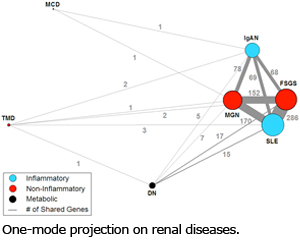- Search NCIBI Data
(e.g. diabetes, csf1r) - Login

HighLights

Matthias Kretzler, M.D.
Professor of Internal Medicine and
Research Professor,
Computational Medicine and
Bioinformatics, Medical School

Charles F. Burant, M.D., Ph.D.
Dr. Robert C. and Veronica Atkins
Professor of Metabolism
Associate Professor of Internal
Medicine Associate Professor of
Molecular and Integrative
 Major Organ-Specific Complications of Diabetes
Major Organ-Specific Complications of Diabetes
We have a concerted systems-level effort to identify genes, transcription factors, mechanisms, networks, and pathways which are causally involved in nephropathy (led by Matthias Kretzler in the Applied Systems Biology Core of the O’Brian Renal Center) and neuropathy (Eva Feldman). We integrate molecular and physiological data to produce metabolic profiles of patient phenotypes (Charles Burant in the Michigan Metabolomics and Obesity Center). And we are extending the metabolomic studies, database, ontology, and visualization from cancers to diabetes (Alla Karnovsky, Chris Beecher). NCIBI data integration systems, data mining, and pathways analyses have transformed this work. We are:
- Identifying molecular signatures in diabetic nephropathy that would help define the active disease process in individual patients.
- Identifying shared transcriptional networks between human and murine diabetic nephropathy and neuropathy using advanced graph matching tools developed by cores 1 and 2, with striking findings for the JAK/STAT pathway.
- Disseminating use of our Nephromine database resource to the international renal research community.
- Exploring mechanisms of glucose-induced oxidative stress underlying neuropathy and nephropathy in diabetes mellitus and in experimental models for prevention. Patients with rapidly progressing disease in kidney and sural nerve biopsies, compared with those with slowly progressing disease, had activation of PPAR-gamma, EGFR, and FOS network nodes.
Related Publications
Wiggin TD, Kretzler M, Pennathur S, Sullivan KA, Brosius FC, Feldman EL. Rosiglitazone treatment reduces diabetic neuropathy in streptozotocin-treated DBA/2J mice. Endocrinology 2008; 149(10): 4928-37. PMID: 18583417.
Sullivan KA, Hayes JM, Wiggin TD, Backus C, Su Oh S, Lentz SI, Brosius F, Feldman EL. Mouse models of diabetic neuropathy. Neurobiol Dis 2007; 28(3): 276-85. PMID: 17804249.

 NCIBI on Facebook
NCIBI on Facebook NCIBI RSS Feed
NCIBI RSS Feed

